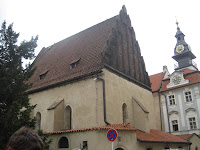
Within the beautiful city of Prague is located the Jewish Quarter, an area that offers a slice of the cities deep history. Originated in the 13th century it was the “Jewish Ghetto” at the time the Jewish community was forced to relocate to these swamp lands where they were contained for centuries(Jewish Quarter). There are 6 synagogues remaining as well as an old hall and a collection of other Jewish historical buildings that predate the areas turn of the 19th century redevelopment, these remaining buildings serve to preserve the history of the location and it goes through reinventions. The area has retained its cobblestone old world feel, only now it has become an upscale locale, very nicely redone, and the old cramped apartments and cramped quarters of the past rebuilt. Remarkably the only reason these buildings continued their existence through World War II was Hitler's intention that Prague be his cultural capital and this quarter to be a museum of an extinct race, so one can imagine how important it is to the community of survivors and their ancestors.
The principal synagogue today is the Old-New Synagogue the oldest still in use in central Europe. It was interesting to me because it was built in early Gothic style and with my limited architectural knowledge I am so used to attributing that style to cathedrals, yet this Gothic is much more medieval than in other parts of the city. While it's name was originally held a different meaning the names was assimilated into culture and changed, it has been a landmark in the community because it's foundation is said to be built with stones from the Temple in Jerusalem borrowed until the messiah comes(Golem's Story). One story of why the synagogue avoided Nazi attention during the War was the Golem that lives in it's attic protecting the people, first creat
 ed long ago by a Rabbi to protect the Jewish population.
ed long ago by a Rabbi to protect the Jewish population.While the ghetto was reconstructed into a neighborhood the Jewish society has been located there since 1096 during the first crusade ,it is hard to imagine a society living in a walled ghetto within Prague and staying a community for so long. You can see how history has changed the different Urban planning and how this planning can then affect what you consider your territory. Or what is considered your territory by someone else, such as the King, but becomes your territory through rituals and ancestry such as in the Jewish quarter.
A breathtaking building was the
 Spanish Synagogue that was build in the Moorish style. We were told that the Moorish style was attributed to the fact that when the Spaniards were under Moorish rule they tolerated Jewish people, thus the community feel back on this style that was comfortable to them and they felt helped them to blend in (Spanish Synagogue).
Spanish Synagogue that was build in the Moorish style. We were told that the Moorish style was attributed to the fact that when the Spaniards were under Moorish rule they tolerated Jewish people, thus the community feel back on this style that was comfortable to them and they felt helped them to blend in (Spanish Synagogue).An interesting piece of city planning that reflects the Jewish niche in Prague society is their cemetery that established in the late 17th century was used for over two centuries and has over 40,000 community members buried there. It is remarkable because those that have passed are buried in 11-12 consecutive layers because they could not get anymore land allotted to them. Here I got chills as you imagine this and you can see tombstones all crunched together. According to the Jewish Museum group the tombstones follow the change in designs of the city from “Baroque, Empire and Romantic to the common...19th century,” styles (Jewish Museum) showing how long this was in use.
One thing I wish I would have taken advantage of was the new permanent exhibitions of the Jewish Museum. Just from seeing one particular exhibition through a window I was tearing up and I caught many other people looking through the window with similar sentiments. There is a collection of pictures drawn by children about life at the camps in WWII. Some of their previous family life other images much more gruesome. Often this is the only record left behind of the life of these many children, thousands of paper paintings representing them. Before their German teacher was also sent to a concentration camp she was able to stash the collection in a suitcase and put it in hiding as her token of remembrance to the innocent.
Overall the Jewish quarter was a unique inside into an imagined community within a larger city, a community that while an international religion clearly has local roots. I saw how territory is divided and also how it shifts, often leaving historical reminders that can help us understand how an area has come to be.
I really enjoyed reading your blog because you gave a very vivid but at the same time informational blog on the Jewish society in Prague. Usually every time that I had thought of Prague I thought of the picturesque society that is filled with beautiful architecture, but had no idea that it maintained such an important aspect of Jewish history. Having visited Dachau in Munich this past weekend, I really enjoyed reading your blog because I just experienced the terrors of the Holocaust. I never knew that Hitler perceived to completely annihilate all Jews and even planned for the future to have museums to remember the Jewish culture.
ReplyDelete